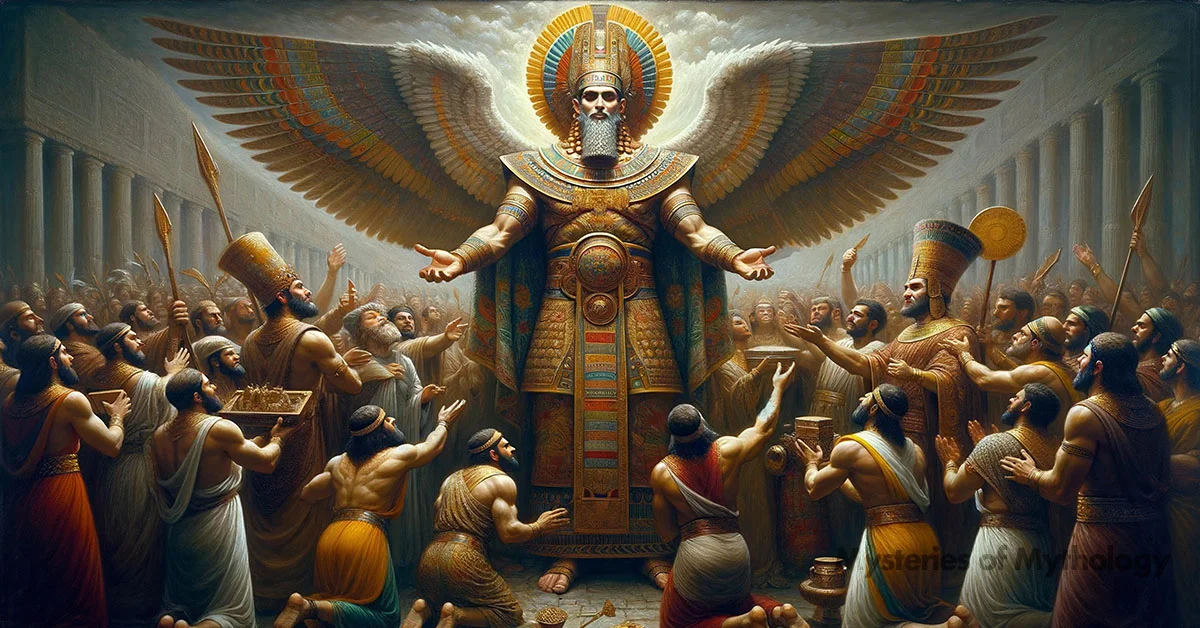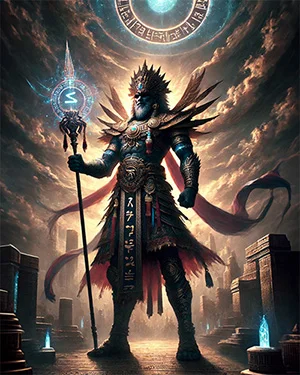Overview
Enlil is a key figure in Mesopotamian mythology, worshipped as the god of wind, air, earth, and storms.
As with all of Mesopotamian mythology, the region has been the home of several empires, and Enlil’s description and role transformed with the rise of the ancient Sumerian, Akkadian, Assyrian, and Babylonian cultures. But, as such a powerful deity embedded in the heart and culture of the region, Enlil’s part in their pantheons endured. Enlil was thought to be so powerful that other gods dared not look upon him.
As one of the most powerful gods, Enlil played an important role in creation myths, the natural world, and the governance of human affairs.
He was believed to be the divine force that shaped existence itself. He was often seen as the link between the gods and humanity, using his power to maintain order and balance. In myths, Enlil’s breath became the wind, his voice was the thunder, and his anger manifested as the storms that swept across the land.
He was portrayed as a wise and authoritative figure who commanded respect and fear from both gods and humans. The city of Nippur was considered his earthly home, and it became a major religious centre where kings sought his favour to legitimise their rule.
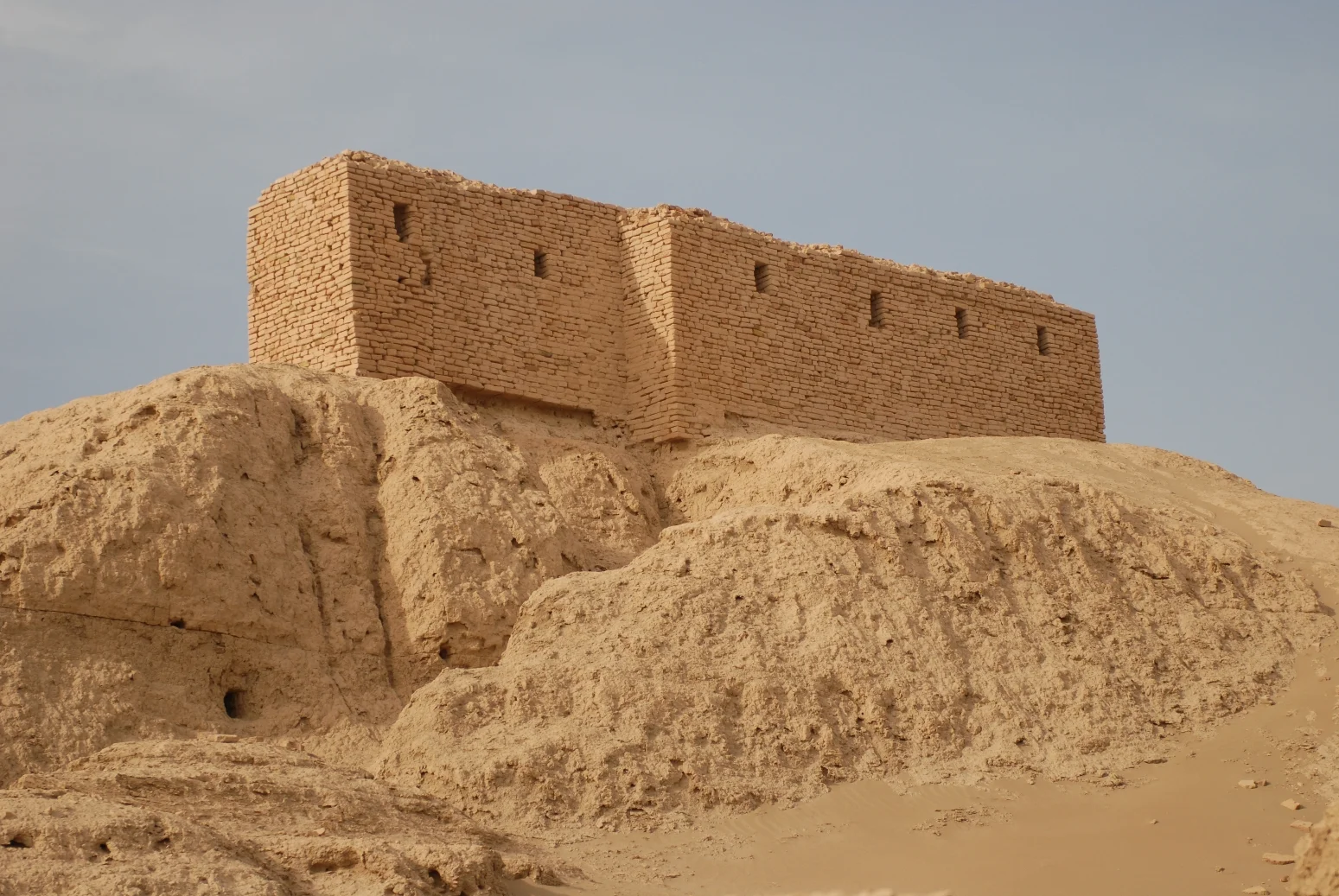
Enlil’s influence went beyond mythology; he also played a significant role in shaping the political and social structures of Mesopotamian society. As a god who could grant kingship and justice, Enlil was invoked in rituals and ceremonies to ensure the prosperity and stability of the realm.
The myths of Enlil often showed his dual nature as both a creator and destroyer, capable of bringing life and destruction. This duality can be seen in stories like the flood myth, where Enlil decides to cleanse the earth to maintain cosmic order, a good example of his complex relationship between humanity and the divine.
Want to know more? Read on…
Watch the related video
Etymology
The name “Enlil” comes from the Sumerian language and is made up of two parts: “En,” meaning “lord,” and “Lil,” meaning “wind” or “breath” or spirit or phantom whose presence may be felt as stirring of the air. So, Enlil is thought to translate to “Lord Wind” or “Lord of the Air”, showing his control over the weather and his important role in both the physical and spiritual worlds of Mesopotamian mythology.
Enlil’s name is one of the oldest recorded in Sumerian texts, dating back to the third millennium BCE. It shows his vital role in the belief system of that era, symbolising the natural forces that were both crucial and intimidating to the people.
The elements of his name are deeply connected to the Sumerian view of the world, where nature’s elements were often considered gods.
Pronunciation
ENGLISH
Enlil
Cuneiform
𒀭𒂗𒆤
PHONETIC
[ˈɛn.lɪl]
IPA
/ˈɛn.lɪl/
Alternate Names
Enlil is known by several names and titles that highlight different aspects of his power and influence. He was also known as “Nunamnir,” a name believed to mean “He Who is Respected,” reflecting his high status within the pantheon. This name portrays Enlil not only as a ruler but also as a wise judge and mediator among the gods.
In various ancient texts, Enlil is referred to as the “King of the Lands” and “Lord of the Storm.” These titles demonstrate his control over natural phenomena, illustrating his power over both the physical world and the destinies of humans and gods.
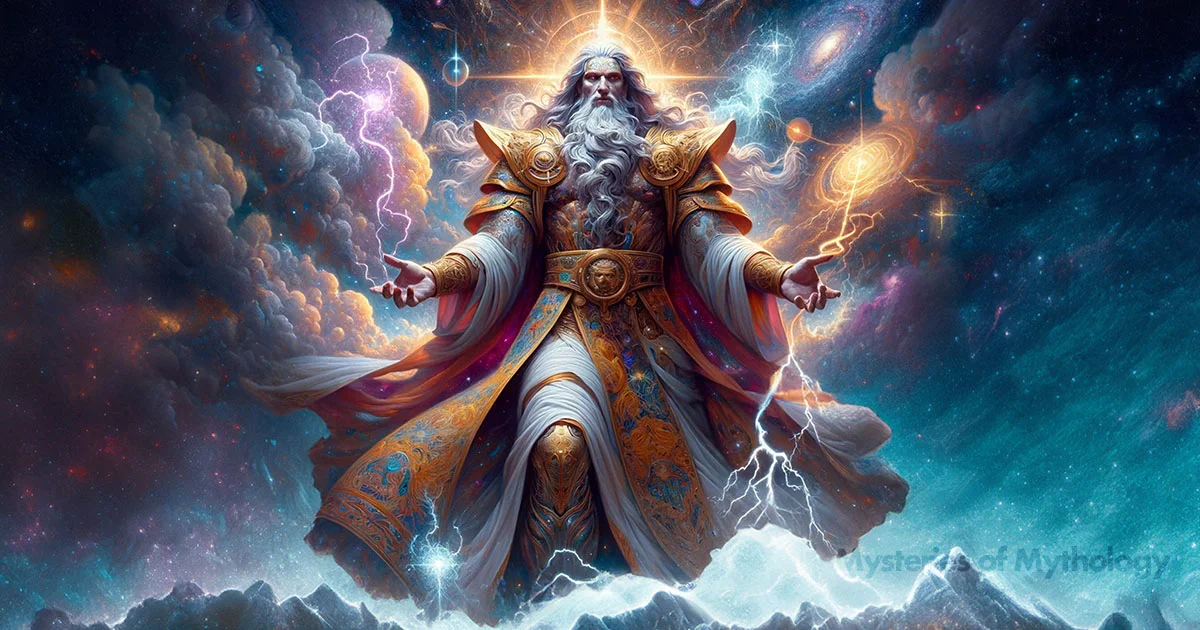
In Akkadian culture, Enlil is sometimes called Ellil. This variation keeps the main parts of his name while adjusting it to the local language. It shows how his worship was included in different cultural traditions without losing his main qualities.
Enlil’s name and titles show his important role in Mesopotamian cosmology. They capture the essence of his divine power and the great respect he had as one of the main gods in the pantheon.
Attributes
Enlil was one of the most powerful and respected gods in Mesopotamian mythology. He was known for his control over the natural world and his influence on the destinies of both gods and humans:
Divine Authority
Lord of the Wind:
Enlil’s main power is his control over the wind and air. He’s seen as the breath of the universe, managing the weather and the elements. This ability makes him both a creator and a destroyer, bringing life with gentle winds and causing destruction with fierce storms.
Supreme Deity:
Enlil was a central figure in the Mesopotamian pantheon. As the “Lord of the Command,” he had the power to decide the fates of gods and humans, acting like a king among gods. His decisions were often final and unquestionable.
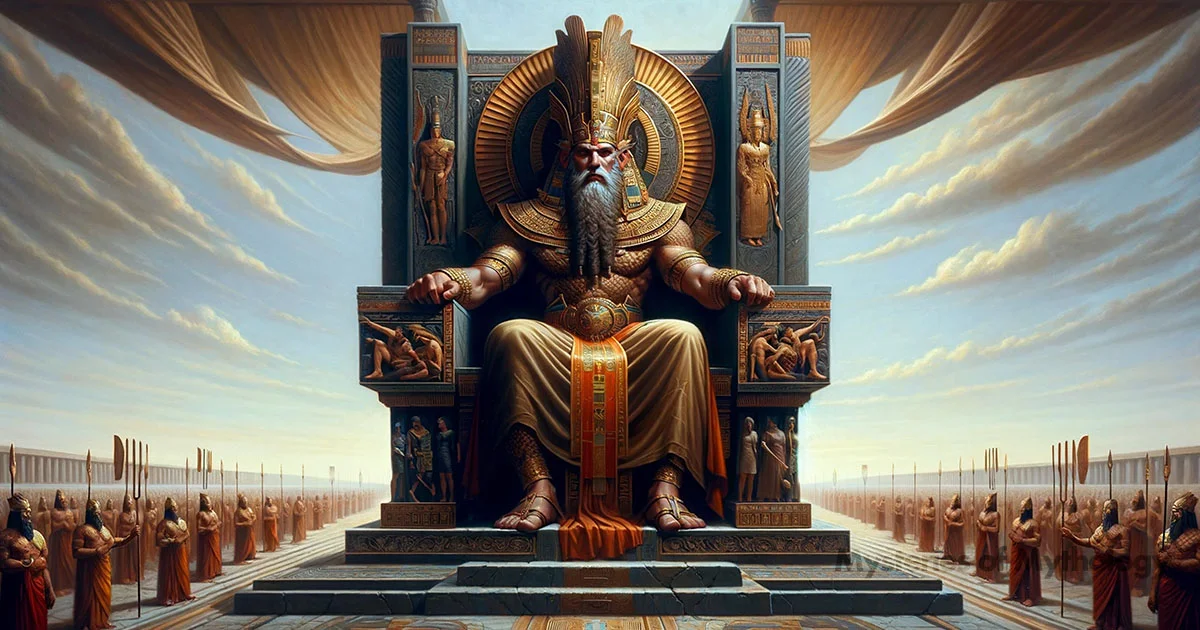
Mediator and Lawgiver:
Enlil was the god who resolved conflicts among gods and maintained order in the universe. He was associated with justice and was believed to enforce divine laws, ensuring harmony and balance in the world.
Tablets of Destiny:
The Tablets of Destiny were central to Enlil’s authority. These mythical tablets were believed to hold the power to control the fates of gods and humans, granting Enlil the authority to decree destinies and maintain cosmic order. His possession of the Tablets symbolised his unparalleled power and his role as the ultimate arbiter of the universe.
Symbols and Representation
Horned Crown:
In Mesopotamian art, Enlil is often shown wearing a horned crown, which symbolises divine authority and power. This crown highlights his supremacy over other deities and his role as king of the gods.
Ekur Temple:
Enlil’s most important temple, the Ekur, located in Nippur, symbolises his earthly home and his link to the heavens. The temple was called the “Mountain House,” representing the connection between the earth and the divine.
Lion-Headed Eagle:
Enlil is sometimes linked to the Anzu bird or lion-headed eagle, a creature that represents his power and ability to control the skies. This association emphasises his dominion over both the natural and spiritual worlds.
Dual Nature
Creator and Destroyer:
Enlil’s dual nature is a key trait. He is credited with creating order from chaos and giving humanity kingship and civilisation. However, he is also known for his destructive power, such as his role in the flood myth, where he aimed to cleanse the earth of humanity because of their noise and sins.
Fertility and Agriculture:
Enlil was closely connected to agriculture and fertility, as his control over wind and rain was crucial for crop growth and survival. People often prayed to him and performed rituals to ensure plentiful harvests. He was also credited with creating the mattock, or hoe, an agricultural tool used for farming. According to the legend of the Hoe tablet, this pickax-like tool was made of pure gold and was a gift from Enlil to humans. They used it to build cities farm and as a weapon. Just as Prometheus brought fire to humans in Greek mythology, Enlil gave humanity the means to farm, build and defend themselves with the pickax.

Enlil’s Role in Society
Patron of Nippur:
As the patron god of Nippur, Enlil played a central role in legitimising kingship and political authority. Rulers sought his favour to gain divine approval and support for their rule, making his temple a key political and religious centre.
Justice and Order:
Enlil’s connection to justice and order also extended to his role as a divine judge. He was believed to enforce laws and uphold moral order, reflecting the values and social norms of Mesopotamian society.
Family
Enlil is one of the main gods in the Mesopotamian pantheon. He was born from the forces that created the universe. His parents are Anu, the sky god, and Ki (also known as Ninhursag), the earth goddess. This makes him a link between the heavens and the earth, connecting both realms.
- Anu: As the supreme sky god, Anu represents the heavens and is seen as the ancestor of many gods. He symbolises authority and divine power.
- Ki (Ninhursag): Ki, the earth goddess, symbolises fertility, creation, and nurturing. Her union with Anu created Enlil and placed him at the centre of the divine hierarchy.
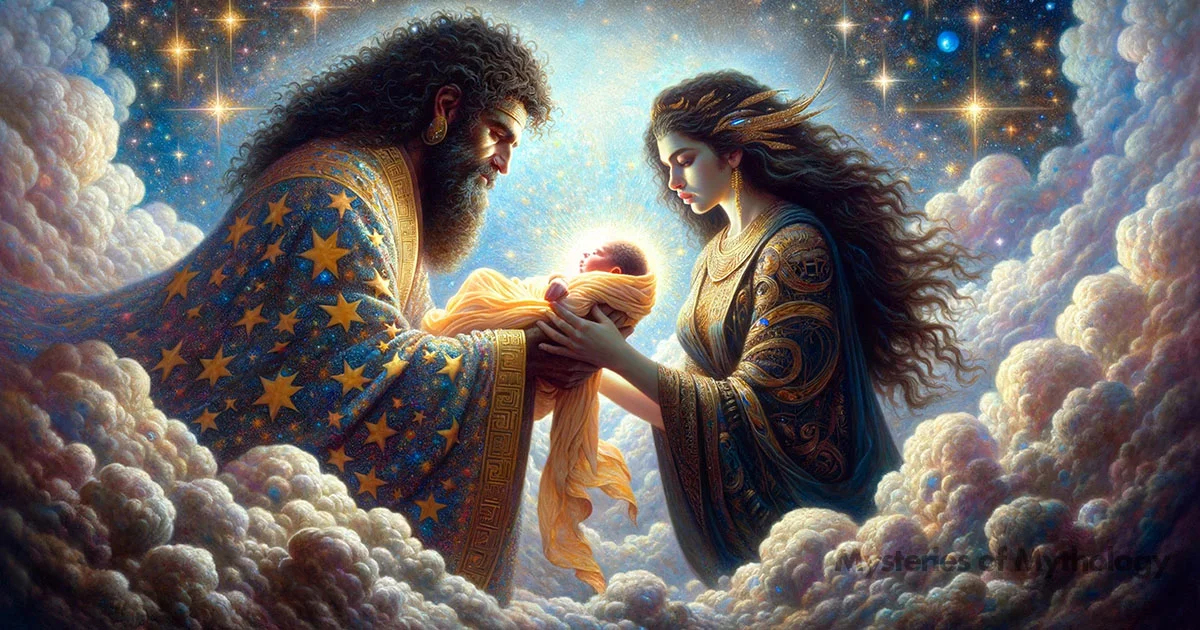
Siblings
Enlil’s siblings are other important gods with key roles in Mesopotamian myths:
- Enki (Ea): Enlil’s brother, Enki, is the god of wisdom, water, and creation. Known for his intelligence, Enki often helps humans in myths, offering guidance and protection.
- Nanna (Sin): The moon god and another sibling, Nanna is linked to time, fertility, and cattle. He plays a vital role in measuring time and regulating agricultural cycles.
Consort
Enlil’s main consort is Ninlil, also known as Sud, the goddess of grain and fertility. Their union symbolises the link between heaven and earth, crucial for the land’s fertility and life’s sustenance.
- Ninlil: As Enlil’s wife, Ninlil shares his duties in maintaining nature’s balance. Together, they represent the harmonious relationship between divine powers sustaining the world.
Children
Enlil and Ninlil have several important children who embody different life and nature aspects:
- Ninurta: The god of war, hunting, and agriculture, Ninurta is known for his strength and heroic deeds. He often appears as a warrior battling chaos to bring order to the world.
- Nanna (Sin): Though also listed as a sibling, some myths refer to Nanna as a son of Enlil and Ninlil, showing the complex nature of Mesopotamian genealogy.
- Nergal: The god of the underworld and death, Nergal is associated with plague and destruction. His dual nature reflects the Mesopotamian view of life and death as interconnected forces.
Family Tree
Parents
Father
Anu
Mother
Ki (Ninhursag)
Siblings
brothers
Enki (Ea), Nanna (Sin)
Consort
Wife
Ninlil (Sud)
Children
Sons
Ninurta, Nergal, Nanna (Sin)
Mythology
The Creation of Humanity
In The Atrahasis (c. 17th century BCE), Enlil played a key role in the creation of humanity. Initially, the gods themselves were tasked with maintaining the universe, which involved laborious activities such as digging canals, tending to crops, and other essential tasks needed for the sustenance of the cosmos. These duties proved to be exhausting for the junior gods, known as the Igigi, who eventually rebelled against their harsh working conditions.
Faced with the gods’ dissatisfaction, Enlil and the other great deities needed a solution to relieve the burden on the Igigi. It was Enki (also known as Ea), the god of wisdom and water, who proposed creating humans to take over these tasks. The gods agreed upon this proposal, leading to the creation of humanity.
The goddess Nintu (also known as Mami or Belet-ili), who was associated with creation and birth, was tasked with forming humans. To craft the first humans, a mixture of clay and the blood of a slain god, one of the Igigi who had led the rebellion was used. This blend symbolised the connection between the divine and the earthly, giving humans life and purpose. The blood of the sacrificed god was believed to impart part of the divine spirit and intelligence to humanity.
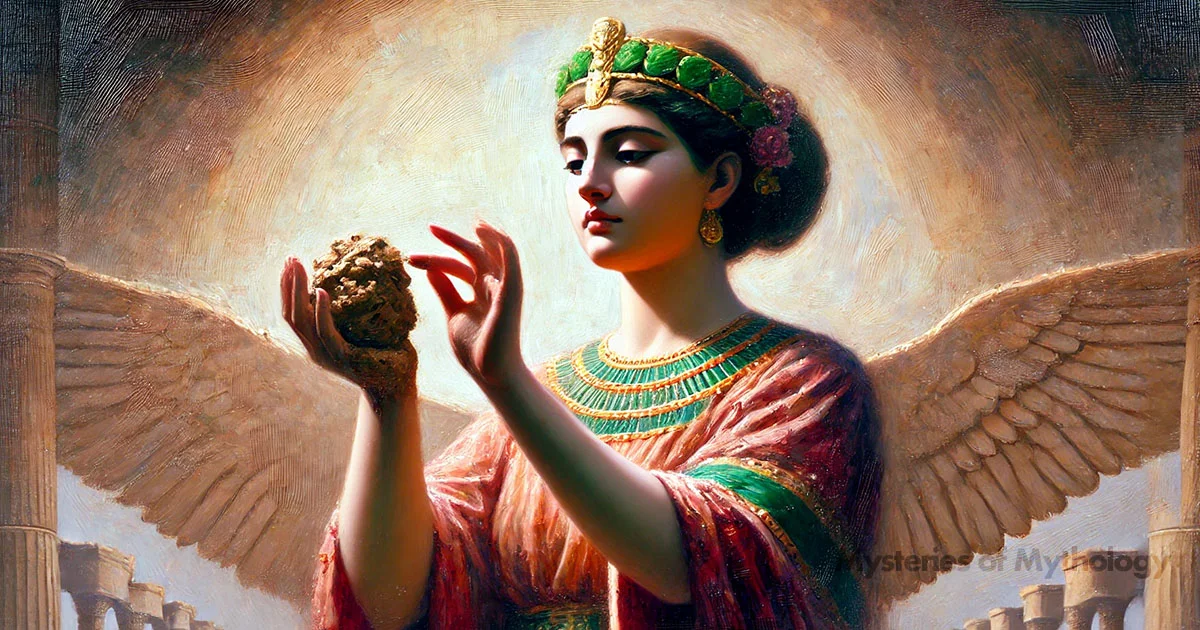
Humans were created to perform the necessary work that the gods found tiresome, such as farming, building, and maintaining the land. This allowed the gods to focus on their divine duties without the burden of physical labour. In return for their service, humans were to honour the gods with rituals and offerings, ensuring a harmonious relationship between the divine and earthly realms.
Another myth related to humanity’s creation can be found in “The Debate Between Sheep and Grain.” In this story, civilisation lacked the essential resources of grain for food and wool for clothing. Anu, the sky god, neglected to provide these vital elements, leaving humanity to live like wild animals. Enlil and Enki recognised this deficiency and decided to grant sheep and grain to humanity.
The gods Ashnan and Uttu, representing grain and sheep, respectively, were introduced to humans as gifts from Enlil. This act allowed humans to grow crops and domesticate animals, laying the groundwork for agriculture and civilisation. Enlil’s decision to give these resources to humanity underscores his desire for human progress and prosperity, fostering a thriving society capable of supporting its gods through rituals and offerings.
The Separation of Heaven and Earth
In the early days of the cosmos, the sky and earth were intertwined in a primordial embrace, representing both potential and chaos. Enlil, the god of air and storms, played a crucial role in transforming this primordial chaos into a structured and habitable world. This myth underscores Enlil’s essential function as an organiser and bringer of order within the universe.
Before Enlil’s intervention, Anu, the sky god, and Ki (also known as Ninhursag), the earth goddess, were unified in a single mass. Their union represented a world without distinction, where the heavens and earth were inseparable. This state of being reflected the early chaotic energies that needed shaping for life to emerge.
Enlil, as the son of Anu and Ki, was destined to bring about change. Recognising that the flourishing of life required separation and definition, Enlil took on the monumental task of dividing the heavens from the earth. This separation was more than a mere physical act; it symbolised the creation of space necessary for life, growth, and the development of civilisation.
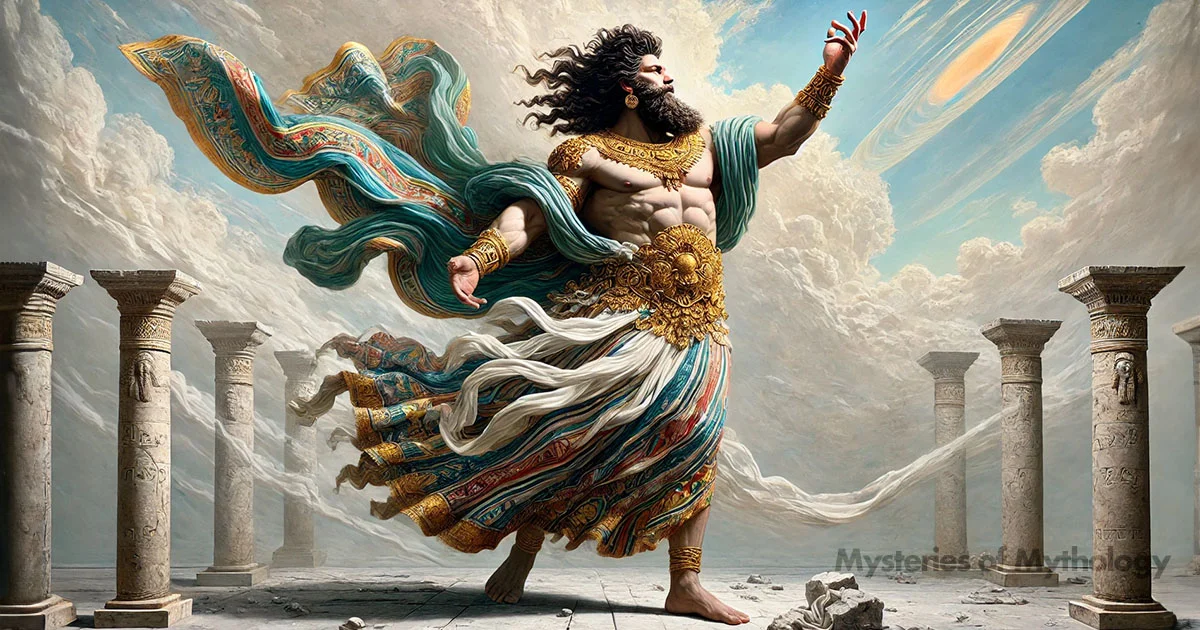
Enlil’s separation of his divine parents was a feat of immense power and authority. By creating the atmosphere and the expanse between heaven and earth, Enlil established the realms in which gods and humans could exist. This act enabled the sky to host the celestial bodies, the earth to support mountains and rivers, and the space between to sustain the air and wind—Enlil’s own domain.
With the separation complete, Enlil had laid the groundwork for the emergence of life and civilisation. The distinction between sky and earth allowed for the cycles of day and night, the seasons, and the nurturing of crops. Enlil’s actions ensured that the cosmos was no longer a chaotic mass but a structured environment where order could prevail and life could flourish.
Through the separation of heaven and earth, Enlil not only defined the physical world but also established the foundation for all life and the stability of the cosmos.
The Great Flood
The story of the Great Flood is one of the most famous myths about Enlil, depicting him as both a creator and a destroyer. In the Epic of Atrahasis and the Epic of Gilgamesh, Enlil becomes frustrated with humanity’s noise and disruption and decides to send a flood to cleanse the earth.
This decision shows just how stern and uncompromising Enlik could be. He saw the flood as a necessary measure to restore balance by silencing humanity once and for all.
Not all gods agreed with Enlil’s harsh judgement. Enki, the wise and compassionate god of water, believed that humans had the potential to change and grow. He decided to give humanity a chance to survive. In secret, Enki warned a righteous man named Ziusudra (or Atrahasis, depending on the version of the myth) about the impending disaster. Enki instructed him to build a large boat (or arc) that could withstand the floodwaters.
Ziusudra followed Enki’s instructions, constructing a large vessel and gathering his family and pairs of animals to preserve life.
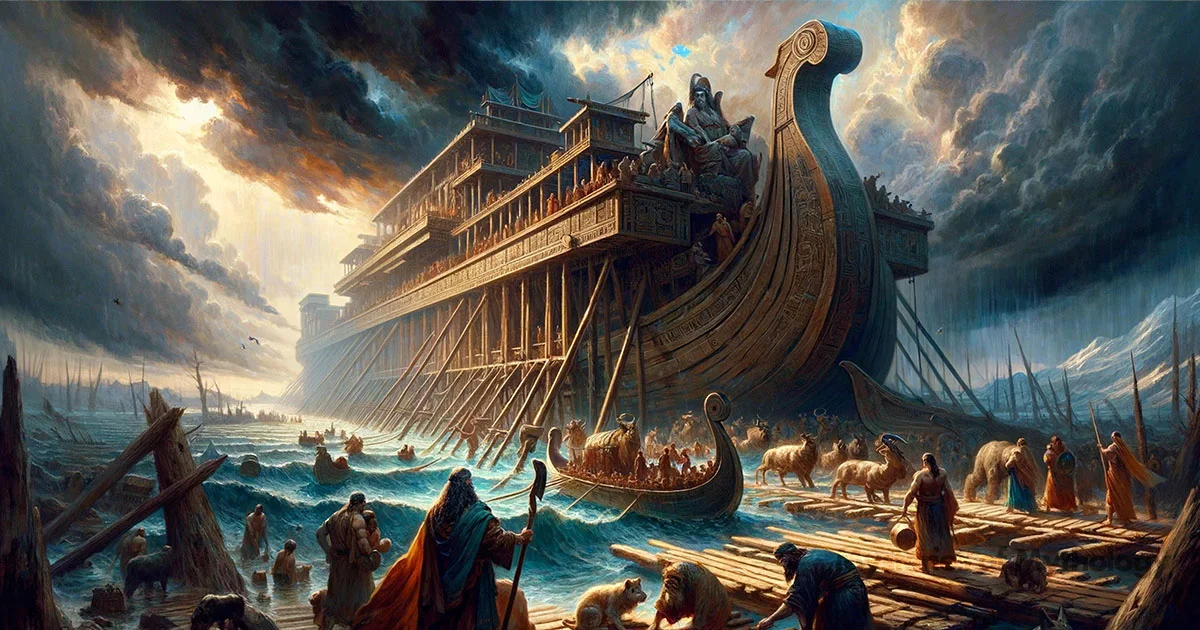
As Enlil had decreed, the skies opened, and rain fell in torrents, with rivers overflowing and the sea swallowing the land. The destruction was immense, and humanity faced near extinction as the flood raged for days and nights.
In the chaos, Ziusudra’s boat floated safely, carrying what would be the future generations of people and animals. Eventually, the rain stopped, and the waters began to recede. The boat came to rest on a mountaintop, and Ziusudra emerged to a world cleansed by the flood. In gratitude, he offered sacrifices to the gods.
When Enlil discovered that some humans had survived, he was initially furious. He had intended to wipe out humanity altogether. However, the other gods, led by Enki, persuaded him to show mercy and acknowledge humanity’s potential for redemption.
Realising the wisdom in Enki’s actions and the righteousness of Ziusudra, Enlil relented and blessed Ziusudra and his descendants. This act of mercy ensured that humanity would continue under divine guidance. It also marked a shift in Enlil’s approach, as he learned to balance his need for order with compassion and understanding, offering a message of renewal and hope.
The Myth of Enlil and Ninlil
The story, written on tablets from the 3rd millennium BCE, starts with the goddess Nisaba warning her daughter, Ninlil, of Enlil’s romantic advances if she bathed in the river. Despite the warning, Ninlil continues to bathe in the river.
Attracted by Ninlil, Enlil approaches her with a mix of charm and mischief. Ninlil resists his first advance, but he finally wins her over, and in a moment of passion, they conceive their first child, Nanna, the moon god.
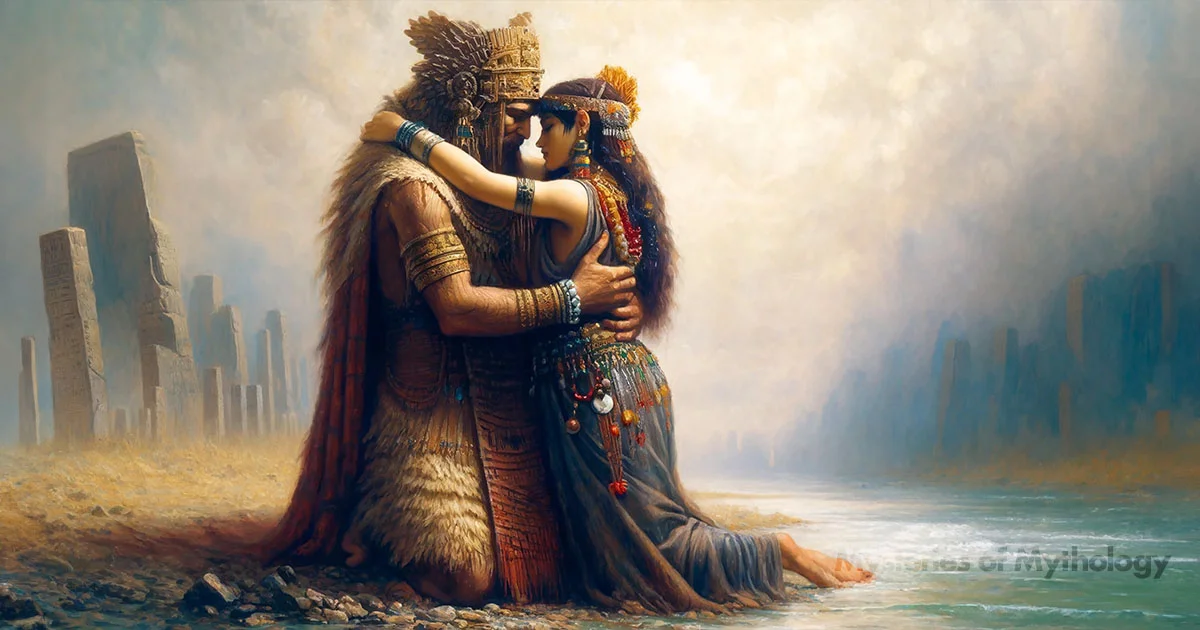
The other gods viewed Enlil’s actions as ritually improper and punished him by sending him into exile to the Sumerian underworld. Despite Enlil’s exile, Ninlil chose to follow him, turning their story into one of forbidden love and loyalty.
Along her journey, Ninlil encountered various men who were actually Enlil in disguise. These encounters led to the conception of more divine offspring, including Nergal, the god of death, and Enbilulu, the god of rivers and canals.
Rather than being condemned for these romantic encounters with different men, Ninlil was praised for her fertility. This is because the story focused on producing multiple divine offspring rather than moral judgment. Some interpretations suggest that Ninlil knew it was him all along.
Ultimately, the myth of Enlil and Ninlil tells the story of Enlil’s transformation from a curious and passionate youth to a powerful deity responsible for shaping the cosmos. It also shows the importance of fertility and procreation in Mesopotamian mythology.
The Conflict with Anzu
This story revolves around the Tablet of Destinies, an artefact with immense power that grants its holder supreme authority over the universe. Enlil, the possessor of the tablet, used it to control the fates of gods and humans, maintaining cosmic balance.
Anzu, a giant bird-like creature with grand ambitions, desired the Tablet of Destinies due to its immense power. One day, taking advantage of a moment when Enlil was distracted and had let down his guard, Anzu stole the tablet. This act caused chaos, disrupting the cosmic order and stripping the gods of their authority.
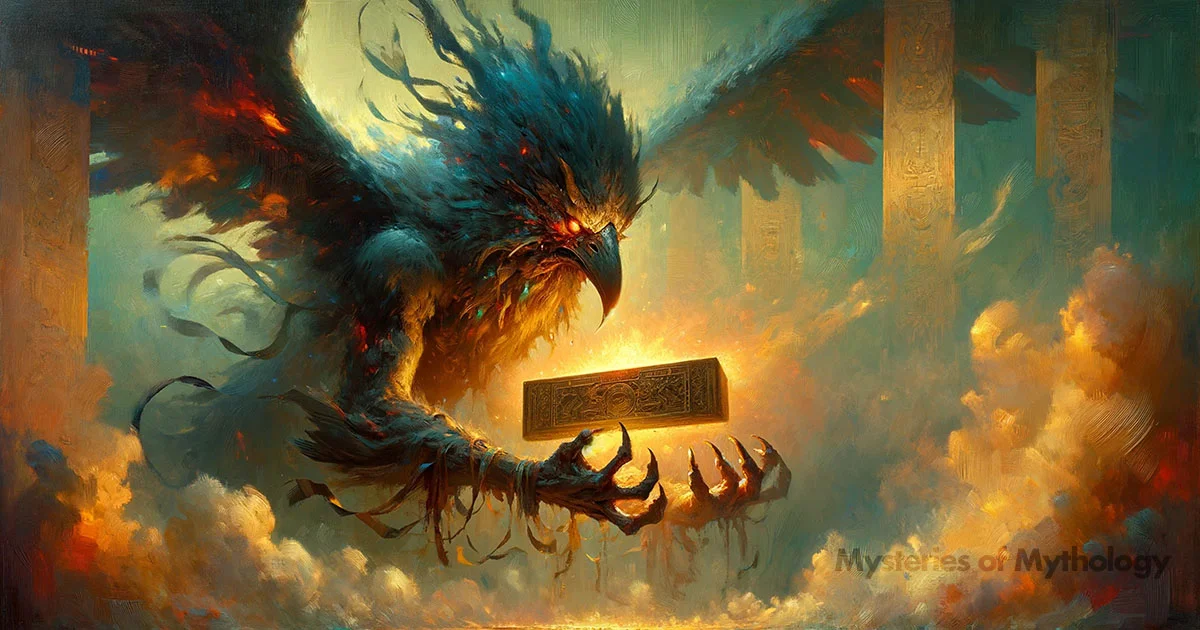
In response to this crisis, Enlil called upon a council of the gods to devise a plan to retrieve the Tablet of Destinies. He summoned various gods, including Adad, Girra, and Shara, to pursue Anzu and recover the artefact. Despite their efforts, none were able to overcome Anzu’s defences and reclaim the tablet.
When the other gods had failed, Ninurta, Enlil’s son, stepped forward to take on the challenge. Known for his strength and bravery, Ninurta set out to confront Anzu, who was armed with divine weapons and his father’s blessing.
The confrontation between Ninurta and Anzu was fierce, with Anzu using the power of the stolen tablet to strengthen himself. However, Ninurta’s determination and skill, combined with Enlil’s support, ultimately allowed him to defeat Anzu and retrieve the Tablet of Destinies.
Once the tablet was restored to Enlil, divine order was reestablished, and the cosmos returned to balance. Ninurta’s success not only reaffirmed Enlil’s authority but also demonstrated the loyalty and respect the gods held for him. Despite the opportunity to seize power, Ninurta chose to honour his father’s leadership.
The Rise of Marduk
In later Babylonian religion, Enlil’s role as the king of the gods was eventually taken over by Marduk. This transition is prominently featured in the *Enuma Elish*, the Babylonian creation epic. After his cosmic victory over Tiamat, the primaeval sea goddess, Marduk established himself as the supreme deity. He “stretched the immensity of the firmament,” and assigned Anu, Enlil, and Ea their respective stations, marking the shift in the divine hierarchy.
Despite being somewhat relegated in the pantheon, Enlil continued to be revered until around 1000 BCE as the high god of Nippur, maintaining his significance in the region. His granddaughter, Ishtar, became the primary female deity in the Mesopotamian pantheon, further ensuring his legacy. Even as Marduk rose to prominence, Enlil remained an important figure throughout the Babylonian and later Persian empires, continuing to be honoured as part of a divine triad with Anu and Ea.
Enlil’s Lasting Legacy
Enlil’s influence extended beyond Mesopotamian borders, leaving a lasting impact on the theological frameworks of neighbouring cultures. As one of the key deities, his characteristics and stories became part of the region’s cultural and religious heritage.
In the Hebrew Bible, figures like Abraham, who was said to have come from “Ur of the Chaldeans” near Nippur, would have been familiar with the stories of Enlil, Anu, and Enki. While Abraham famously rejected the polytheism of Babylonian religion, elements of Enlil’s myths, such as the Great Flood, appear in Israelite traditions. In these stories, however, there is only one God, with Yahweh embodying the roles of both Enlil and Enki as both the originator of the flood and the one who warns Noah of its coming.
Enlil, also known as Ellil, may have influenced the development of the concept of El, the chief god in the Canaanite religion and a name associated with the God of Abraham, Isaac, and Jacob in the Hebrew Bible. Some scholars see parallels between the rise of Marduk in Babylonian mythology and Yahweh in Israelite tradition, reflecting how new deities often supplanted older ones in ancient religious landscapes.
Enlil’s earlier position as the sky deity and king of the gods may have also influenced the Greek concept of Zeus, although Marduk was directly associated with the planet Jupiter. Enlil’s legacy is a testament to the enduring influence of Mesopotamian mythology, shaping the beliefs and religious narratives of cultures far beyond its original borders.
Worship
Enlil was one of the most respected gods in Mesopotamia, playing a central role in the region’s religious and cultural life. As the god of wind, air, earth, and storms, Enlil influenced many aspects of daily life, including agriculture and politics.
Temples and Sacred Sites
- Ekur Temple in Nippur: The primary centre of Enlil’s worship was the Ekur Temple, located in the city of Nippur. Known as the “Mountain House,” this temple was considered Enlil’s earthly abode and was a significant spiritual and political centre. Nippur was not a political capital but a religious hub where kings from various city-states would travel to seek Enlil’s blessing and legitimacy for their reigns.
- Architectural Significance: The Ekur Temple was an architectural marvel reflecting Enlil’s grandeur and divine authority. It featured large ziggurats, a rectangular stepped tower, and courtyards where rituals and offerings were conducted. The temple was a place of pilgrimage and was often associated with celestial events and agricultural cycles.
Rituals and Offerings
- Daily Offerings: Enlil’s priests performed daily rituals that included offerings of food, drink, and incense to honour and appease the god. These offerings were meant to ensure Enlil’s favour and maintain the community’s harmony and prosperity.
- Prayer and Hymns: Enlil was the subject of numerous prayers and hymns, many of which have been preserved in cuneiform tablets. These hymns celebrated his power, wisdom, and role in maintaining cosmic order. They were recited during ceremonies and festivals to invoke his protection and guidance.
Festivals and Ceremonies
- Akitu Festival: One of the most important festivals in honour of Enlil was the Akitu, or New Year festival, which marked the beginning of the agricultural season. The Akitu festival was a time of renewal and reaffirmation of the king’s divine mandate to rule. It involved processions, reenactments of creation myths, and rituals that symbolised the regeneration of the earth and society.
- King’s Rituals: As part of the Akitu festival, the king would participate in rituals to demonstrate his humility before Enlil and his role as the god’s earthly representative. This included acts of penance and renewal of the king’s vows to uphold justice and prosperity.
Enlil’s Role in Society
- Legitimizing Kingship: Enlil was seen as the ultimate authority who granted kingship to rulers. His favour was essential for a king to maintain power and legitimacy. Many kings would dedicate temples and monuments to Enlil, seeking his endorsement and support in their political endeavours. This tradition continued in some form with future civilisations in Mesopotamia.
- Maintaining Order: As a god of justice and order, Enlil’s worship was integral to Mesopotamian society’s legal and moral frameworks. Priests and officials invoked Enlil’s name in judicial matters, believing that his divine wisdom would guide fair and just outcomes.
Influence on Mesopotamian Culture
- Cultural Legacy: The worship of Enlil left a lasting impact on subsequent cultures and religions in the region. His attributes and myths were absorbed into later deities, influencing the development of religious thought and practice beyond Mesopotamia.
Pop Culture
Video Games
- “Final Fantasy” Series: Enlil is referenced in several games within the “Final Fantasy” series, which often incorporates mythological elements into its world-building. In “Final Fantasy Legend II,” Enlil is one of the deities players encounter, reflecting his attributes as a god of storms and wind. The series’ use of mythological names and concepts helps introduce players to ancient cultures in an engaging way.
Music
- “Enlil” by Therion: The Swedish symphonic metal band Therion released a song titled “Enlil” on their 2010 album “Sitra Ahra.” The song explores themes related to Enlil’s mythological background, emphasising his power and authority. Therion is known for drawing inspiration from various mythologies, and their music often incorporates epic and historical themes.
Comics and Graphic Novels
- “God Is Dead”: In the comic series “God Is Dead,” written by Jonathan Hickman and Mike Costa, Enlil is depicted as one of the gods who returns to earth. The series explores a world where deities from various mythologies vie for control, and Enlil’s inclusion highlights the diverse range of mythological figures represented. This series brings ancient myths into a modern context, showing how these stories can be reimagined in contemporary narratives.
Educational Media
- Documentaries and TV Series: Enlil has been featured in documentaries and educational programs exploring ancient civilisations. Shows such as the “History Channel’s” series on ancient gods and myths often include segments on Mesopotamian deities, discussing Enlil’s role in the pantheon and his influence on the culture and religion of the time.
Frequently Asked Questions
Who was Enlil?
Enlil was a major deity in ancient Mesopotamian mythology, worshipped as the god of wind, air, earth, and storms. He was one of the most important gods in the Sumerian pantheon, often regarded as the king of the gods.
Why did Enlil flood the earth?
Enlil decided to flood the earth because he was displeased with humanity’s noise and behaviour, which disrupted the peace of the gods. The flood was intended to reset creation and restore order.
What is Enlil the god of?
Enlil is the god of wind, air, earth, and storms. He is also associated with authority and kingship and plays a crucial role in maintaining order and justice in the cosmos.
Are Enlil and Enki brothers?
Yes, Enlil and Enki are considered brothers in Mesopotamian mythology. Both are sons of the sky god Anu, and they often have contrasting roles, with Enki being associated with water, wisdom, and creation.
What does Enlil’s epithet Nunamnir mean?
Nunamnir is an epithet for Enlil that signifies his role as a powerful and authoritative god. It highlights his status as the chief deity responsible for the laws and decrees governing the universe.
References
- Beaulieu, Paul-Alain. The Pantheon of Uruk During the Neo-Babylonian Period. Brill, 2003.
- Bertman, S. Handbook to Life in Ancient Mesopotamia. Oxford University Press, 2005.
- Black, J. & Green, A. Gods, Demons and Symbols of Ancient Mesopotamia. University of Texas Press, 1992.
- Budge, E. A. Wallis. Babylonian Life and History. Barnes & Noble, 2005.
- Clayton, Matt. Sumerian Mythology: Captivating Myths Of Gods, Goddesses, And Legendary Creatures of Ancient Sumer and Their Importance To The Sumerians. Captivating History, 2019.
- Coleman, J.A. The Dictionary of Mythology: An A-Z of Themes, Legends, and Heroes. Barnes & Noble, Inc., 2007.
- Cotterell, Arthur. Oxford Dictionary of World Mythology. Oxford University Press, 1997.
- Gibson, McGuire. Nippur, Sacred City of Enlil, Supreme God of Sumer and Akkad. Oriental Institute, University of Chicago, 1997.
- Hooke, S.H. Middle Eastern Mythology. Dover Publications, 2013.
- Jacobsen, T. The Treasures of Darkness. Yale University Press, 1978.
- Kriwaczek, P. Babylon: Mesopotamia and the Birth of Civilization. St. Martin’s Griffin, 2012.
- Mark, Joshua J. Enlil. World History Encyclopedia, 2017.
- McCall, Henrietta. Mesopotamian Myths. University of Texas Press, 1990.
- Schomp, Virginia. The Ancient Mesopotamians. Marshall Cavendish Benchmark, 2009.
- Stone, Adam.Enlil/Ellil (god). Ancient Mesopotamian Gods and Goddesses, Oracc and the UK Higher Education Academy, 2016.

